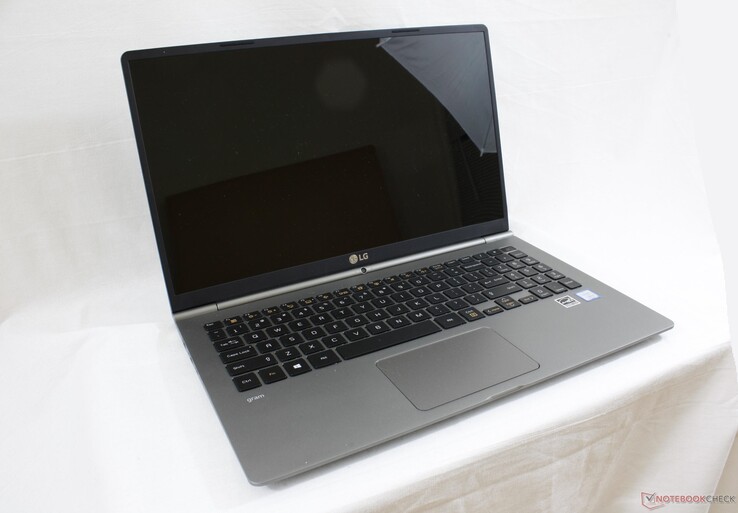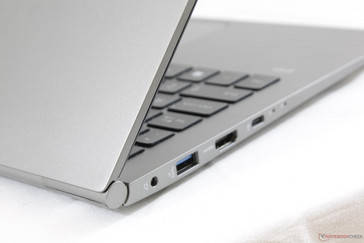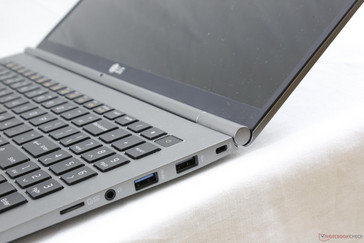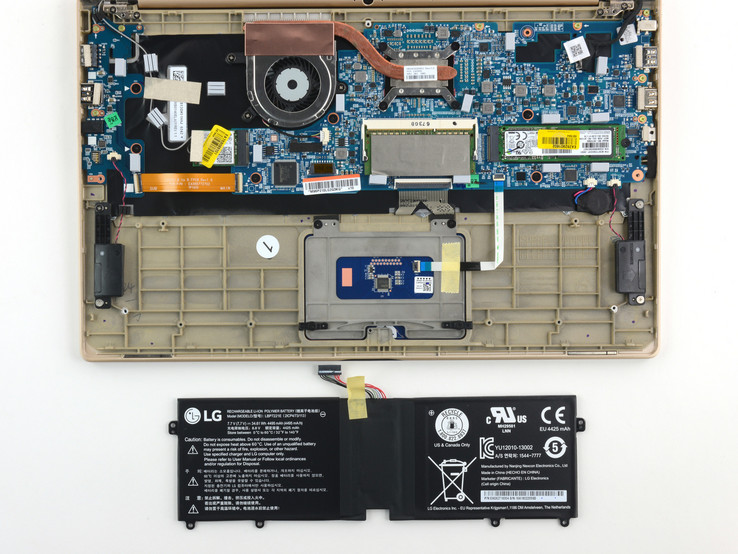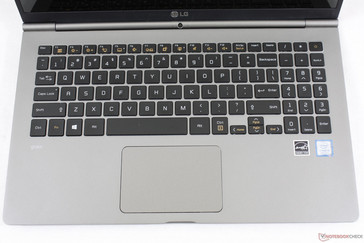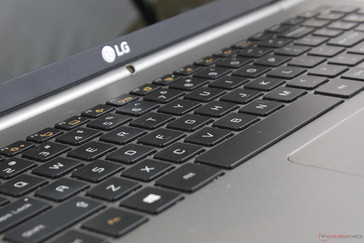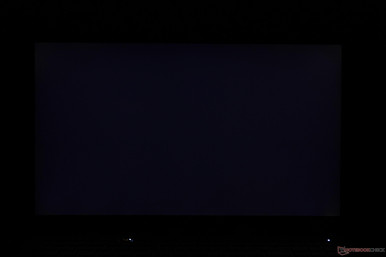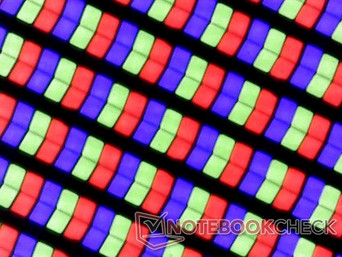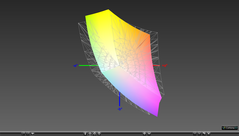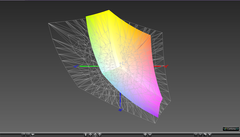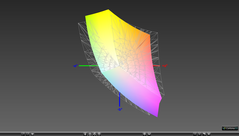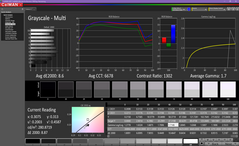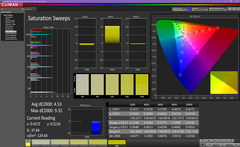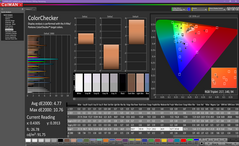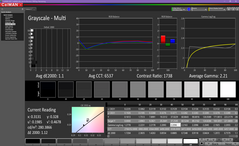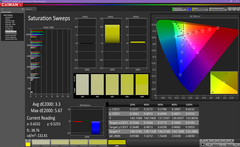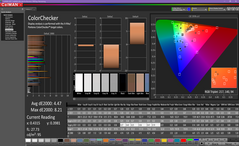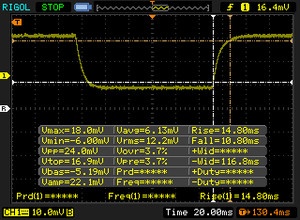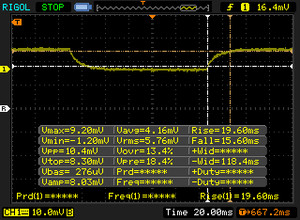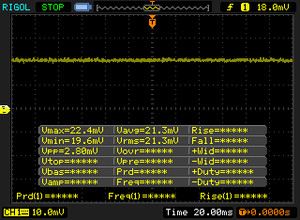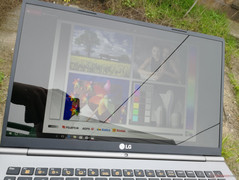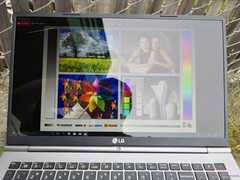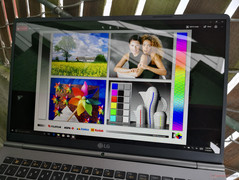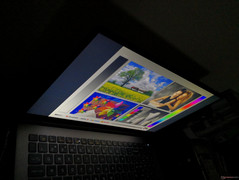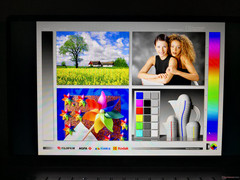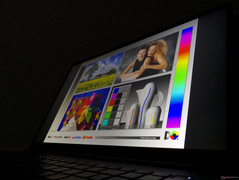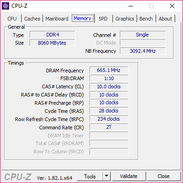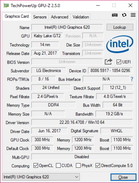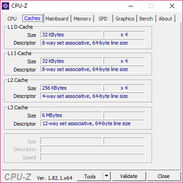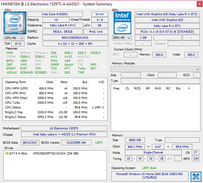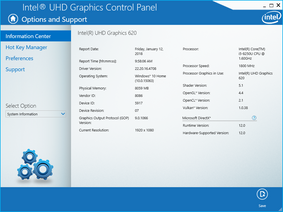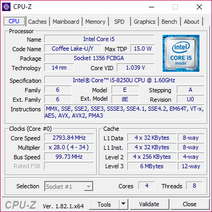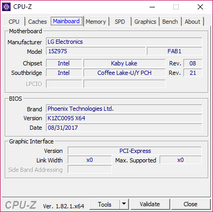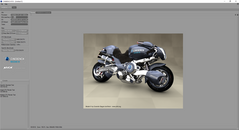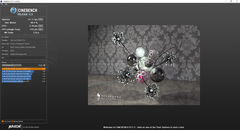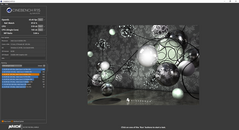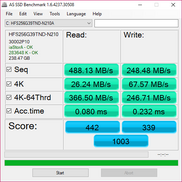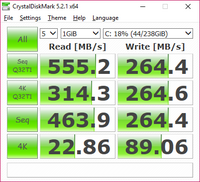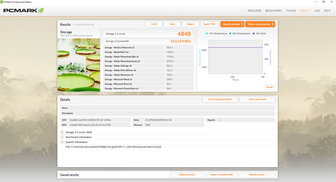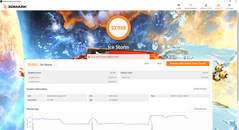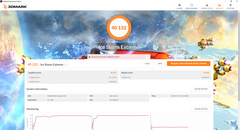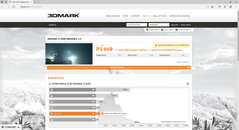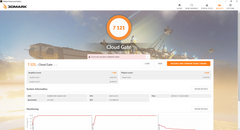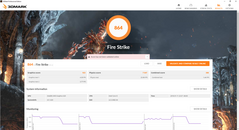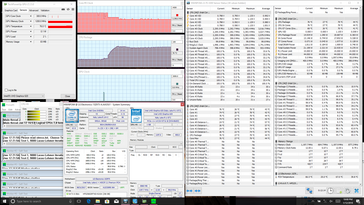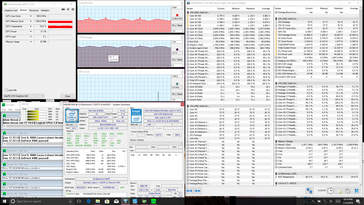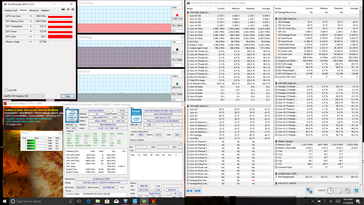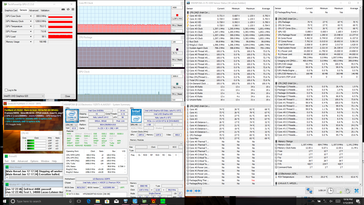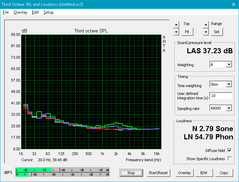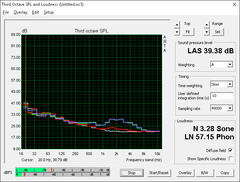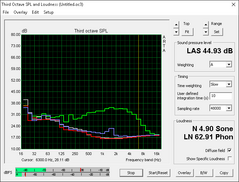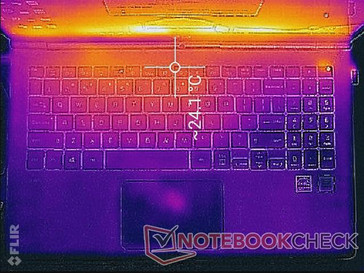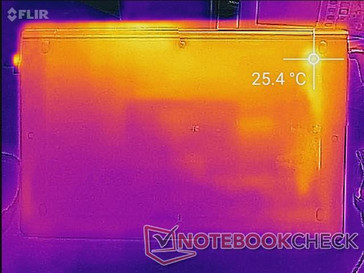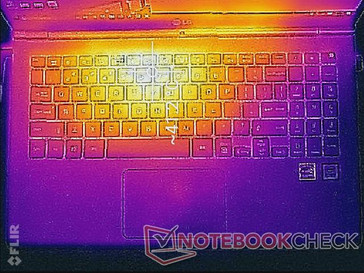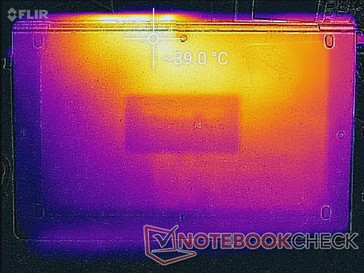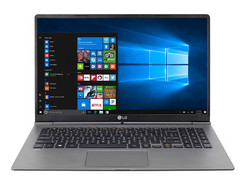LG Gram 15 (i5-8250U, FHD) Laptop Review
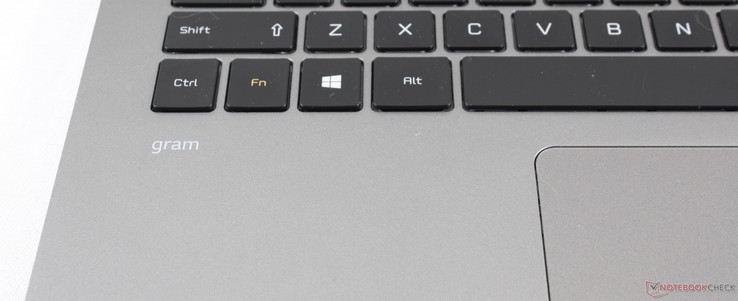
As its name suggests, the LG Gram series emphasizes lightweight and portability to a stronger degree than other competing Ultrabooks. The end result is a very light system that offers the familiar core basics of an Ultrabook without the extra weight in an attempt to cater to students and frequent travelers.
Our unit today is the 15.6-inch Gram 15Z975 equipped with a Core i5-8250U CPU, 8 GB of DDR4 RAM, 256 GB SSD, and FHD IPS display for about $1100 USD. Note that a newer redesigned Gram 15Z980 model is also available with the Core i7-8550U CPU, double the RAM, NVMe SSD, integrated Thunderbolt 3 interface, MIL-STD 810G certification, larger battery capacity, and other upgrades that we will visit at a later date. For this review, we will focus on the Gram 15Z975 and the inevitable cutbacks LG had to make in order to offer a 1.1 kg 15.6-inch notebook without resorting to slower, passively cooled CPUs.
Competition in the 15-inch space is fierce. Common alternatives include the Dell XPS 15, Spectre x360 15, Acer Swift 3, Asus ZenBook Pro UX550, Huawei MateBook D, Samsung Notebook 9 NP900, and the Lenovo Yoga 720. With the exception of the Samsung, all the above laptops are significantly heavier than our LG, slightly pricier, and come with more overall features.
Case
The Gram 15Z975 utilizes a "nano carbon" magnesium alloy chassis with a uniform matte surface from top to bottom. It's a subdued traditional design that incorporates no notable "gimmick" such as HP's piston hinges, Lenovo's watchband hinges, Dell's carbon fiber surfaces, or other marketable keywords that notebook purists may appreciate. Still, the darkened gray appears a bit dull compared to the brighter and more unique Ultrabooks currently available.
As light as the chassis may be, its rigidity is inferior to every other 15-inch Ultrabook we've tested with the possible exception of the Samsung Notebook 9. The lid is especially easy to twist and warp from its front two corners and down its center, respectively. The extra-narrow bezels and lack of an edge-to-edge glass overlay both contribute to a flimsier screen. Similarly, the base is also more susceptible to twisting and warping around the palm rests and keyboard compared to systems like the XPS 15 or Spectre x360 15. The flexibility of the Gram 15 can be partly attributed to the very thin chassis material that makes the notebook feel hollow, fragile, and not nearly as sound as competing models. It's here that the major drawback to such a lightweight design becomes apparent.
The weak hinge is just barely strong enough to prevent teetering when typing and it unfortunately becomes looser at wider angles. The lid still teeters when first opening the system from a closed position and we would have definitely preferred a more rigid hinge as a result.
Other than its weak impression, the construction quality of our Gram test unit is excellent with no defects or unintended gaps between materials. Twisting the lid or base moderately will cause minor audible creaking that we don't consider to be a manufacturing issue.
The light weight of the Gram 15 is the main selling point of the notebook. At just under 1.1 kg, the LG weighs about the same as a Surface Pro with Type Cover and is quite literally almost half the weight of the XPS 15 while offering the same 15.6-inch screen size and very nearly the same dimensions. Even the smaller 15.0-inch Samsung Notebook 9 NP900X5N, which is one of the lightest Windows notebooks available when considering the size, is slightly heavier than the Gram 15. The weight advantage is immediately noticeable compared to other more popular 15-inch Ultrabooks as we're not talking just a few grams difference here and there, but several hundred. Users will have no issues carrying or handling the notebook with one hand - just be sure not to ding the fragile edges or corners against other objects.
Connectivity
Surprisingly, the Gram 15 is able to incorporate most of the essential ports in spite of its light weight. Its 3x USB Type-A ports in particular is notable as more and more Ultrabooks are dropping this particular feature in favor of thinner form factors. Nonetheless, it would have been great to see a full-size SD reader and USB Type-C charging instead of the proprietary AC adapter port. It's worth noting that the latest Gram 15Z980 refresh has updated the USB Type-C Gen.1 port on our 15Z975 to Thunderbolt 3 for an even wider range of connectivity options.
Port positioning is excellent as all ports are evenly spaced, easy to reach, and not too close to the front with at least one USB port on either side.
SD Card Reader
Transfer rates from the integrated spring-loaded MicroSD reader are about 85 MB/s for both read and write to be very similar to the Samsung Notebook 9 NP900X5N. Note that our Toshiba THN-M401S0640E2 MicroSD test card is rated for a maximum transfer rate of 90 MB/s and that a potentially faster card may return faster numbers.
A fully inserted MicroSD card protrudes by about 1 mm for safe carrying and easy ejecting.
| SD Card Reader | |
| average JPG Copy Test (av. of 3 runs) | |
| Dell XPS 15 9560 (i7-7700HQ, UHD) | |
| LG Gram 15Z975 | |
| Samsung Notebook 9 NP900X5N-X01US | |
| maximum AS SSD Seq Read Test (1GB) | |
| Dell XPS 15 9560 (i7-7700HQ, UHD) | |
| Samsung Notebook 9 NP900X5N-X01US | |
| LG Gram 15Z975 | |
Communication
WLAN and Bluetooth 4.2 are provided by the common Intel 8265 module capable of theoretical transfer rates of up 867 Mbps. We experienced no recurring connectivity issues when connected to our Linksys EA 8500 test router.
WAN and GPS features are not available on the series.
| Networking | |
| iperf3 transmit AX12 | |
| Dell XPS 15 9560 (i7-7700HQ, UHD) | |
| LG Gram 15Z975 | |
| Samsung Notebook 9 NP900X5N-X01US | |
| iperf3 receive AX12 | |
| Samsung Notebook 9 NP900X5N-X01US | |
| Dell XPS 15 9560 (i7-7700HQ, UHD) | |
| LG Gram 15Z975 | |
Accessories
Included extras are a warranty card and USB Type-C to RJ-45 adapter. A cleaning cloth or carrying sleeve would have made the out-of-box experience even better.
Maintenance
The bottom is secured by 8 Philips screws hidden underneath circular covers and the rubber footing as detailed by iFixit here. These covers and footing require a sharp edge or a small pair of tweezers to remove since they are glued very tightly to the case. Otherwise, the internals are relatively easy to access.
We would have expected the RAM, storage, and WLAN modules to be soldered in order to reduce weight, but they are all surprisingly removable and upgradeable.
Warranty
The standard one-year limited manufacturer warranty applies. Owners can register their purchases and file repair requests online directly through the manufacturer. LG's online store currently holds no stock of the Gram series for customers in the US.
Input Devices
Keyboard
The backlit keyboard (~31.8 x 10.8 cm) is a standard QWERTY layout with NumPad, half-sized Arrow keys, and a recessed Power button on the top right. Tactile feedback is noticeably spongier compared to the XPS 15, Samsung Notebook 9, Lenovo Precision keyboard, and the Spectre x360 15. Perhaps a more rigid underlying base for the keyboard could have made for a firmer typing experience. On the bright side, feedback feels uniform from corner to corner and is quiet due in part to the spongy keystroke.
The NumPad keys are narrower and more tightly grouped than the main QWERTY keys to save on space. Along with the small Arrow keys, the NumPad can feel cramped as a result.
Touchpad
The trackpad (10.3 x 6.9 cm) is smaller than the trackpads on the XPS 15 (10.5 x 8.5 cm) and Samsung Notebook 9 (11.0 x 8.0 cm). Its surface is completely smooth for an easier glide in contrast to the the slightly roughened palm rests or outer lid. We experienced no issues with jumping cursors, sticky fingers, or delayed responses.
The integrated mouse keys along the bottom edge of the trackpad are softer and spongier than the same clickpad on the Yoga 910. There is strong auditory feedback when pressed, but tactility is poor and could have been firmer.
Display
Current Gram 15 SKUs are limited to the FHD IPS touchscreen with no matte or higher resolution options. As noted earlier, the Gram is one of the few touchscreen-enabled notebooks that do not utilize edge-to-edge glass protection and it instead relies on thin glossy plastic. As a result, the screen feels fragile when tapping with a finger when compared to your typical Android tablet or convertible notebook. The forced glossy panel is also disadvantageous for reducing glare since brightness levels are only average.
LG provides the LP156WFA-SPC1 IPS panel for its own Gram notebooks with excellent contrast levels, no pulse-width modulation, and average black-white response times. This exact panel is found on no other 15-inch notebook in our database and it is likely unique to the Gram series. Subjectively, text and images appear crisp and free of color grains that often plague matte panels. Very slight uneven backlight bleeding is present along the bottom edge of our unit, but it is minimal at worst and never distracting.
| |||||||||||||||||||||||||
Brightness Distribution: 89 %
Center on Battery: 273 cd/m²
Contrast: 1241:1 (Black: 0.22 cd/m²)
ΔE Color 4.77 | 0.5-29.43 Ø5
ΔE Greyscale 8.6 | 0.57-98 Ø5.3
76.9% sRGB (Argyll 1.6.3 3D)
50.2% AdobeRGB 1998 (Argyll 1.6.3 3D)
56.3% AdobeRGB 1998 (Argyll 2.2.0 3D)
77.1% sRGB (Argyll 2.2.0 3D)
54.9% Display P3 (Argyll 2.2.0 3D)
Gamma: 1.7
| LG Gram 15Z975 ID: LGD052A, Name: LG Philips LP156WFA-SPC1, IPS, 15.60, 1920x1080 | Acer Swift 3 SF315-51G-57E5 BOE NV156FHM-N48, IPS, 15.60, 1920x1080 | Dell XPS 15 9560 (i7-7700HQ, UHD) IGZO IPS, 15.60, 3840x2160 | Samsung Notebook 9 NP900X5N-X01US ID: BOE06E8, Name: BOE HF NV150FHB-N31, IPS, 15.00, 1920x1080 | HP Envy 15-as133cl Chi Mei CMN15D8, IPS, 15.60, 1920x1080 | Dell Inspiron 15 7570 BOE06B4, IPS, 15.60, 1920x1080 | |
|---|---|---|---|---|---|---|
| Display | -26% | 57% | 22% | -20% | -25% | |
| Display P3 Coverage | 54.9 | 39.86 -27% | 89.7 63% | 65.2 19% | 42.95 -22% | 40.43 -26% |
| sRGB Coverage | 77.1 | 58.7 -24% | 100 30% | 97.7 27% | 64.3 -17% | 60 -22% |
| AdobeRGB 1998 Coverage | 56.3 | 41.18 -27% | 100 78% | 67.2 19% | 44.41 -21% | 41.77 -26% |
| Response Times | -22% | -58% | -22% | -22% | -29% | |
| Response Time Grey 50% / Grey 80% * | 35.2 ? | 42 ? -19% | 57.2 ? -63% | 40.8 ? -16% | 44.4 ? -26% | 45 ? -28% |
| Response Time Black / White * | 25.6 ? | 32 ? -25% | 39.2 ? -53% | 32.4 ? -27% | 30 ? -17% | 33 ? -29% |
| PWM Frequency | 21000 ? | 962 | 208.3 ? | 1000 ? | 996 ? | |
| Screen | -2% | 13% | 30% | -11% | 8% | |
| Brightness middle | 273 | 248 -9% | 370.1 36% | 565.6 107% | 262.3 -4% | 255 -7% |
| Brightness | 276 | 237 -14% | 356 29% | 524 90% | 240 -13% | 240 -13% |
| Brightness Distribution | 89 | 79 -11% | 87 -2% | 88 -1% | 83 -7% | 91 2% |
| Black Level * | 0.22 | 0.21 5% | 0.37 -68% | 0.49 -123% | 0.24 -9% | 0.16 27% |
| Contrast | 1241 | 1181 -5% | 1000 -19% | 1154 -7% | 1093 -12% | 1594 28% |
| Colorchecker dE 2000 * | 4.77 | 4.98 -4% | 5.3 -11% | 2 58% | 5 -5% | 4.74 1% |
| Colorchecker dE 2000 max. * | 10.76 | 8.41 22% | 9.9 8% | 5 54% | 20.6 -91% | 7.68 29% |
| Greyscale dE 2000 * | 8.6 | 4.26 50% | 4.6 47% | 2.5 71% | 3.2 63% | 3.44 60% |
| Gamma | 1.7 129% | 2.37 93% | 2.31 95% | 2.21 100% | 2.45 90% | 2.43 91% |
| CCT | 6678 97% | 7149 91% | 6284 103% | 6896 94% | 6817 95% | 7064 92% |
| Color Space (Percent of AdobeRGB 1998) | 50.2 | 38 -24% | 88.3 76% | 61.2 22% | 40.5 -19% | 38 -24% |
| Color Space (Percent of sRGB) | 76.9 | 58 -25% | 100 30% | 97.5 27% | 63.5 -17% | 60 -22% |
| Total Average (Program / Settings) | -17% /
-9% | 4% /
12% | 10% /
21% | -18% /
-14% | -15% /
-3% |
* ... smaller is better
Color space is approximately 77 percent and 50 percent of the sRGB and AdobeRGB standards, respectively. Colors are deeper than on the mainstream Acer Swift 3 and Envy 13 notebooks, but costlier models like the Samsung Notebook 9 or XPS 15 can cover essentially all of sRGB for potentially more accurate colors. The Gram is a comfortable middle-ground in terms of color reproduction, though certainly not accurate enough for professional graphics work where full sRGB is desired.
Further analyses with a X-Rite spectrophotometer reveal an inaccurate average gamma of 1.7 compared to the target 2.2 for sRGB. Grayscale and colors are subsequently inaccurate with the color teal being the least accurate of all the primary and secondary colors. Our calibration attempts improve both gamma and grayscale significantly and we recommend an end-user calibration to get the most out of the display. Colors still grow increasingly inaccurate at higher saturation levels due to imperfect sRGB coverage.
Display Response Times
| ↔ Response Time Black to White | ||
|---|---|---|
| 25.6 ms ... rise ↗ and fall ↘ combined | ↗ 14.8 ms rise | |
| ↘ 10.8 ms fall | ||
| The screen shows relatively slow response rates in our tests and may be too slow for gamers. In comparison, all tested devices range from 0.1 (minimum) to 240 (maximum) ms. » 56 % of all devices are better. This means that the measured response time is worse than the average of all tested devices (21.5 ms). | ||
| ↔ Response Time 50% Grey to 80% Grey | ||
| 35.2 ms ... rise ↗ and fall ↘ combined | ↗ 19.6 ms rise | |
| ↘ 15.6 ms fall | ||
| The screen shows slow response rates in our tests and will be unsatisfactory for gamers. In comparison, all tested devices range from 0.2 (minimum) to 636 (maximum) ms. » 43 % of all devices are better. This means that the measured response time is similar to the average of all tested devices (33.7 ms). | ||
Screen Flickering / PWM (Pulse-Width Modulation)
| Screen flickering / PWM not detected | |||
In comparison: 53 % of all tested devices do not use PWM to dim the display. If PWM was detected, an average of 17900 (minimum: 5 - maximum: 3846000) Hz was measured. | |||
Outdoor visibility is average at best because of the glossy panel. The backlight is nowhere near as powerful as on a MacBook Pro or Samsung Notebook 9 and glare is inevitable. As usual, we recommend avoiding direct skylight if needing to work for extended periods. Viewing angles are otherwise very wide as expected from an IPS panel with no major color shifting and only slight brightness/contrast changes from extreme angles.
Performance
CPU options are limited to Intel's ULV Core ix series with no dedicated GPUs as the graphics chipset would have added significantly more weight. Users looking for Ultrabooks with more graphics horsepower may want to consider the Acer Swift 3 with Vega 8 graphics or the heavier HP Spectre x360 with GeForce options.
Processor
The Core i5-8250U in the Gram 15 performs slightly slower than where we expect the processor to be. The HP ProBook 470 G5 with the exact same CPU, for example, is 16 percent faster in multi-threaded loads according to CineBench R15. The discrepancy can be attributed to performance throttling as shown by our CineBench stress test loop results below. Our already low initial score of 532 points drops steadily over time to an average of 495 points after a handful of repetitions to represent a performance drop of about 7 percent. In short, maximum Turbo Boost benefits are short-lived on the LG and generally unreliable for stressful tasks.
Despite the throttling, CPU performance is still well above the last generation ULV Kaby Lake family in multi-threaded tasks due largely to its doubled processing units. Users jumping from the i5-7200U to the i5-8250U in the Gram 15 will observe a jump of almost 60 percent in multi-threaded performance. Meanwhile, the competing Ryzen 5 2500U is surprisingly comparable to the i5-8250U, though the AMD solution is unfortunately still scarce in the notebook market.
See our dedicated page on the Core i5-8250U CPU for more technical information and benchmark comparisons.
| wPrime 2.10 - 1024m | |
| Lenovo ThinkPad 25 | |
| Dell Latitude 5280 | |
| Microsoft Surface Laptop i7 | |
| Razer Blade Stealth QHD i7-8550U | |
| Dell Inspiron 15 7000 7577 | |
| LG Gram 15Z975 | |
| HP Envy x360 15m-bq121dx | |
* ... smaller is better
System Performance
PCMark benchmarks rank our Gram 15 slightly slower than the Acer Swift 3 (8250U, GeForce MX150) but above last year's ThinkPad 25 (7500U, GeForce 940MX). Systems with dedicated GeForce Pascal graphics will still outclass the LG.
Subjectively, we experienced no notable software issues during testing. Navigating across the OS is smooth as one would expect from a SSD-based PC.
| PCMark 8 Home Score Accelerated v2 | 3557 points | |
| PCMark 8 Creative Score Accelerated v2 | 4651 points | |
| PCMark 8 Work Score Accelerated v2 | 4736 points | |
| PCMark 10 Score | 3391 points | |
Help | ||
Storage Devices
Internal storage is limited to a single M.2 2280 slot with no NVMe options. Our particular test unit is equipped with a 256 GB SK Hynix HFS256G39TND SSD with transfer rates not unlike most SATA III SSDs. Sequential read and write rates top out at 555 MB/s and 264 MB/s, respectively, which is noticeably faster than the smaller 128 GB SSD in the Acer Swift 3 from the same manufacturer. Nonetheless, the lack of NVMe is somewhat disappointing given the 4-digit price point of the notebook.
See our growing table of HDDs and SSDs for more benchmark comparisons.
| LG Gram 15Z975 SK Hynix HFS256G39TND-N210A | Acer Swift 3 SF315-51G-57E5 Hynix HFS128G39TND | Dell XPS 15 9560 (i7-7700HQ, UHD) Lite-On CX2-8B512-Q11 | Samsung Notebook 9 NP900X5N-X01US Samsung PM961 MZVLW256HEHP | Dell Inspiron 15 7570 Samsung PM961 NVMe MZVLW512HMJP | |
|---|---|---|---|---|---|
| AS SSD | -20% | 203% | 269% | -127% | |
| Copy Game MB/s | 179.8 | 112.3 -38% | 540 200% | 648 260% | |
| Copy Program MB/s | 141.2 | 97.9 -31% | 411.5 191% | 497.9 253% | |
| Copy ISO MB/s | 197.5 | 130.3 -34% | 1272 544% | 1685 753% | |
| Score Total | 1003 | 854 -15% | 2810 180% | 3906 289% | 1455 45% |
| Score Write | 339 | 204 -40% | 1022 201% | 928 174% | 68 -80% |
| Score Read | 442 | 437 -1% | 1206 173% | 2011 355% | 960 117% |
| Access Time Write * | 0.232 | 0.273 -18% | 0.034 85% | 0.03 87% | 4.391 -1793% |
| Access Time Read * | 0.08 | 0.101 -26% | 0.034 57% | 0.043 46% | 0.04 50% |
| 4K-64 Write | 246.7 | 114.1 -54% | 789 220% | 674 173% | 40.26 -84% |
| 4K-64 Read | 366.5 | 355.3 -3% | 962 162% | 1709 366% | 736 101% |
| 4K Write | 67.6 | 77.5 15% | 112.2 66% | 124.1 84% | 1 -99% |
| 4K Read | 26.24 | 29.84 14% | 41.34 58% | 48.71 86% | 44.3 69% |
| Seq Write | 248.5 | 124 -50% | 1207 386% | 1299 423% | 271.5 9% |
| Seq Read | 488.1 | 515 6% | 2026 315% | 2533 419% | 1800 269% |
* ... smaller is better
GPU Performance
The integrated UHD Graphics 620 provides no significant improvements over the HD Graphics 620 found on 7th generation ULV Core ix CPUs. Thus, even the aging GeForce 930MX is almost 60 percent faster than our LG Gram while the new Vega 8 in the competing AMD Ryzen 5 2500U can be over twice as powerful according to 3DMark benchmarks. This isn't generally a problem as the Gram is not meant for gaming and it is still able to stream 4K UHD video without issues, but there's no denying that Intel's HD Graphics series could use an update on future Core ix revisions.
See our dedicated page on the UHD Graphics 620 for more technical information and benchmark comparisons.
| 3DMark | |
| 1280x720 Cloud Gate Standard Graphics | |
| HP Envy x360 15m-bq121dx | |
| Microsoft Surface Laptop i7 | |
| Razer Blade Stealth QHD i7-8550U | |
| HP ProBook 470 G5 | |
| Asus Transformer 4 Pro (i7-7500U, HD620) | |
| LG Gram 15Z975 | |
| Acer TravelMate P257-M-56AX | |
| HP 250 G5 SP X0N33EA | |
| Teclast Tbook 16 Power | |
| 1920x1080 Fire Strike Graphics | |
| HP Envy x360 15m-bq121dx | |
| HP ProBook 470 G5 | |
| Microsoft Surface Laptop i7 | |
| LG Gram 15Z975 | |
| Asus Transformer 4 Pro (i7-7500U, HD620) | |
| 1920x1080 Ice Storm Extreme Graphics | |
| HP ProBook 470 G5 | |
| LG Gram 15Z975 | |
| 3DMark 11 Performance | 1668 points | |
| 3DMark Ice Storm Standard Score | 52051 points | |
| 3DMark Cloud Gate Standard Score | 7121 points | |
| 3DMark Fire Strike Score | 864 points | |
Help | ||
| low | med. | high | ultra | |
| BioShock Infinite (2013) | 49 | 28 | 23 | 7.5 |
| Rise of the Tomb Raider (2016) | 17 | 10 |
Stress Test
We stress the notebook to identify for any potential throttling or stability issues. When running Prime95, the CPU can be observed operating at 2.6 GHz for only the first 30 seconds or so until core temperature reaches 80 C. Eventually, processor clock rates slowly decline before stabilizing in the 2.0 GHz to 2.3 GHz range with a fluctuating core temperature between 75 C and 80 C as shown by the screenshots below. While clock rates are still well above the 1.6 GHz base, the unsteady Turbo Boost performance may upset the small subset of users who desire maximum clock rates out of a ULV CPU. The initial higher boost in CPU performance is reflected upon our CineBench R15 loop test from above.
Stressing both the CPU and integrated GPU will throttle the CPU down to just 1.3 GHz with a steady core temperature of 75 C. Such a behavior is typical of Ultrabooks and the LG Gram is no different in this regard.
Running on battery power will not throttle the CPU or GPU. A 3DMark 11 run on batteries returns Physics and Graphics scores 5771 and 1504 points, respectively, compared to 5729 and 1517 points when on mains.
| CPU Clock (GHz) | GPU Clock (MHz) | Average CPU Temperature (°C) | |
| Prime95 Stress | 2.0 - 2.3 | -- | 75 - 80 |
| FurMark Stress | -- | 898 | 75 |
| Prime95 + FurMark Stress | 1.3 | 798 | 75 |
Emissions
System Noise
The cooling solution consists of a single fan and heat pipe. The heat pipe is shorter in length compared to most notebooks likely to save on weight.
The notebook fan is silent during low loads like word processing and remains almost inaudible during video playback. Running the first benchmark scene of 3DMark06 will bring the fan up to 32.5 dB(A), which is still very quiet and unobtrusive. When compared to other 15-inch models like the Swift 3, Envy 15, or Notebook 9, the LG is slightly quieter and with a more lethargic fan.
Longer periods of gaming or extreme stress will induce a maximum fan noise of 37.2 dB(A). This is a bit louder than expected from an Ultrabook with no dedicated GPU, but still generally unobtrusive and far less noisy than the more powerful XPS 15.
Noise Level
| Idle |
| 29.2 / 29.2 / 29.2 dB(A) |
| Load |
| 32.5 / 37.2 dB(A) |
 | ||
30 dB silent 40 dB(A) audible 50 dB(A) loud |
||
min: | ||
| LG Gram 15Z975 UHD Graphics 620, i5-8250U, SK Hynix HFS256G39TND-N210A | Acer Swift 3 SF315-51G-57E5 GeForce MX150, i5-8250U, Hynix HFS128G39TND | Dell XPS 15 9560 (i7-7700HQ, UHD) GeForce GTX 1050 Mobile, i7-7700HQ, Lite-On CX2-8B512-Q11 | Samsung Notebook 9 NP900X5N-X01US GeForce 940MX, i7-7500U, Samsung PM961 MZVLW256HEHP | HP Envy 15-as133cl HD Graphics 620, i7-7500U, HGST Travelstar 5K1000 HTS541010A7E630 | Acer Swift 3 SF315-41-R4W1 Vega 8, R5 2500U, Intel SSD 600p SSDPEKKW256G7 | |
|---|---|---|---|---|---|---|
| Noise | -4% | -13% | -2% | -7% | -6% | |
| off / environment * | 29.2 | 30.5 -4% | 28.4 3% | 28.3 3% | 30 -3% | 31.8 -9% |
| Idle Minimum * | 29.2 | 30.5 -4% | 29 1% | 28.3 3% | 32.5 -11% | 31.8 -9% |
| Idle Average * | 29.2 | 30.5 -4% | 29 1% | 28.3 3% | 32.5 -11% | 32.1 -10% |
| Idle Maximum * | 29.2 | 30.9 -6% | 32.2 -10% | 28.3 3% | 32.5 -11% | 32.1 -10% |
| Load Average * | 32.5 | 35.7 -10% | 47.1 -45% | 38.3 -18% | 38.7 -19% | 33 -2% |
| Load Maximum * | 37.2 | 35.6 4% | 47.1 -27% | 38.3 -3% | 32.5 13% | 34.8 6% |
| Witcher 3 ultra * | 52 |
* ... smaller is better
Temperature
Surface temperatures are generally flat on both sides of the notebook during low loads with no noticeable warm spots. When subjected to extreme processing loads, the hot spots near the rear of the system can be as warm as 41 C. Fortunately, the palm rests and main QWERTY keys never become uncomfortably warm. The low 40 C range during high loads is common on Ultrabooks with ULV CPUs while more powerful Ultrabooks like the Zenbook Pro UX550 or XPS 15 can reach 50 C on their respective hot spots.
(±) The maximum temperature on the upper side is 41.4 °C / 107 F, compared to the average of 36.9 °C / 98 F, ranging from 21.1 to 71 °C for the class Multimedia.
(+) The bottom heats up to a maximum of 39.4 °C / 103 F, compared to the average of 39.1 °C / 102 F
(+) In idle usage, the average temperature for the upper side is 23 °C / 73 F, compared to the device average of 31.2 °C / 88 F.
(+) The palmrests and touchpad are cooler than skin temperature with a maximum of 24.2 °C / 75.6 F and are therefore cool to the touch.
(+) The average temperature of the palmrest area of similar devices was 28.8 °C / 83.8 F (+4.6 °C / 8.2 F).
Speakers
The stereo 1 W speakers are "tinny" in quality because of poor bass reproduction as shown by our pink noise graph below. Competing Ultrabooks like the Spectre 13 or XPS 15 are much more capable of reproducing lower frequencies than the LG. While the speakers are disappointing, maximum volume is at least satisfactory for home or small conference environments. A pair of headphones are recommended for music and video playback.
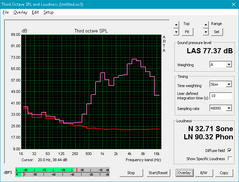
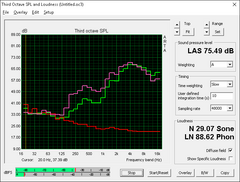
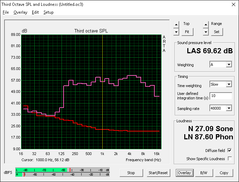
LG Gram 15Z975 audio analysis
(-) | not very loud speakers (71.9 dB)
Bass 100 - 315 Hz
(-) | nearly no bass - on average 28.2% lower than median
(+) | bass is linear (2.6% delta to prev. frequency)
Mids 400 - 2000 Hz
(±) | reduced mids - on average 7.6% lower than median
(-) | mids are not linear (18.4% delta to prev. frequency)
Highs 2 - 16 kHz
(±) | higher highs - on average 9.8% higher than median
(±) | linearity of highs is average (9.4% delta to prev. frequency)
Overall 100 - 16.000 Hz
(-) | overall sound is not linear (42.9% difference to median)
Compared to same class
» 99% of all tested devices in this class were better, 0% similar, 0% worse
» The best had a delta of 5%, average was 18%, worst was 45%
Compared to all devices tested
» 95% of all tested devices were better, 0% similar, 5% worse
» The best had a delta of 4%, average was 25%, worst was 134%
Apple MacBook 12 (Early 2016) 1.1 GHz audio analysis
(+) | speakers can play relatively loud (83.6 dB)
Bass 100 - 315 Hz
(±) | reduced bass - on average 11.3% lower than median
(±) | linearity of bass is average (14.2% delta to prev. frequency)
Mids 400 - 2000 Hz
(+) | balanced mids - only 2.4% away from median
(+) | mids are linear (5.5% delta to prev. frequency)
Highs 2 - 16 kHz
(+) | balanced highs - only 2% away from median
(+) | highs are linear (4.5% delta to prev. frequency)
Overall 100 - 16.000 Hz
(+) | overall sound is linear (10.2% difference to median)
Compared to same class
» 5% of all tested devices in this class were better, 2% similar, 93% worse
» The best had a delta of 5%, average was 19%, worst was 53%
Compared to all devices tested
» 3% of all tested devices were better, 1% similar, 96% worse
» The best had a delta of 4%, average was 25%, worst was 134%
Frequency Comparison (Checkbox selectable!)
Graph 1: Pink Noise 100% Vol.; Graph 2: Audio off
Energy Management
Power Consumption
The Gram 15 draws about 4 W to 10 W depending on the screen brightness and Power Profile setting when idling on desktop to be comparable to other 15-inch Ultrabooks powered by 15 W ULV CPUS. Gaming or very high loads will demand about 35 W from a small 40 W AC adapter. In comparison, The 15.6-inch Acer Swift 3 with the same CPU draws about 20 W more than our LG when under stressful loads to correlate well with its more powerful 25 W GeForce MX150 GPU.
| Off / Standby | |
| Idle | |
| Load |
|
| LG Gram 15Z975 i5-8250U, UHD Graphics 620, SK Hynix HFS256G39TND-N210A, IPS, 1920x1080, 15.60 | Acer Swift 3 SF315-51G-57E5 i5-8250U, GeForce MX150, Hynix HFS128G39TND, IPS, 1920x1080, 15.60 | Samsung Notebook 9 NP900X5N-X01US i7-7500U, GeForce 940MX, Samsung PM961 MZVLW256HEHP, IPS, 1920x1080, 15.00 | HP Envy 15-as133cl i7-7500U, HD Graphics 620, HGST Travelstar 5K1000 HTS541010A7E630, IPS, 1920x1080, 15.60 | HP Envy x360 15m-bq121dx R5 2500U, Vega 8, HGST Travelstar 7K1000 HTS721010A9E630, IPS, 1920x1080, 15.60 | Apple MacBook Pro 15 2017 (2.9 GHz, 560) i7-7820HQ, Radeon Pro 560, , , 2880x1800, 15.40 | |
|---|---|---|---|---|---|---|
| Power Consumption | -12% | -32% | 16% | -21% | -73% | |
| Idle Minimum * | 4.4 | 3.8 14% | 5 -14% | 4.6 -5% | 5.9 -34% | 3.7 16% |
| Idle Average * | 9.1 | 6.5 29% | 11.6 -27% | 7.7 15% | 8.7 4% | 16.2 -78% |
| Idle Maximum * | 9.6 | 9.1 5% | 12.2 -27% | 7.8 19% | 10.5 -9% | 18 -88% |
| Load Average * | 34.8 | 53.4 -53% | 47.8 -37% | 30.5 12% | 45.7 -31% | 58.4 -68% |
| Load Maximum * | 36 | 55.6 -54% | 55.7 -55% | 22.7 37% | 49.4 -37% | 89.6 -149% |
| Witcher 3 ultra * | 51.9 | 45.8 |
* ... smaller is better
Battery Life
The non-removable 60 Wh battery provides about 7 hours of real-world WLAN use to be similar to the XPS 15 when subjected to the same testing conditions. The Dell solution, of course, is equipped with more demanding processors that are offset by the much larger 97 Wh battery. Though not as long-lasting as the Samsung Notebook 9 NP900X5N or MacBook Pro 15 by about 2 hours each, the 7-hour runtime is still respectable considering the overall lower weight of the LG.
Charging from near empty to full capacity is very slow at about 3 hours with the included AC adapter whereas most other Ultrabooks can recharge fully in 1.5 to 2 hours.
| LG Gram 15Z975 i5-8250U, UHD Graphics 620, 60 Wh | Acer Swift 3 SF315-51G-57E5 i5-8250U, GeForce MX150, 49.7 Wh | Dell XPS 15 9560 (i7-7700HQ, UHD) i7-7700HQ, GeForce GTX 1050 Mobile, 97 Wh | Samsung Notebook 9 NP900X5N-X01US i7-7500U, GeForce 940MX, 66 Wh | Dell Inspiron 15 7570 i5-8550U, GeForce 940MX, 42 Wh | HP Envy 15-as133cl i7-7500U, HD Graphics 620, 52 Wh | |
|---|---|---|---|---|---|---|
| Battery Runtime | 17% | -15% | 27% | -63% | -33% | |
| Reader / Idle | 1078 | 831 -23% | 1642 52% | 280 -74% | 573 -47% | |
| WiFi v1.3 | 435 | 511 17% | 434 0% | 604 39% | 105 -76% | 408 -6% |
| Load | 131 | 103 -21% | 116 -11% | 80 -39% | 72 -45% |
Pros
Cons
Verdict
Similar to how the "world's thinnest notebook" must sacrifice certain aspects of the design to reach the desired marketing blurb, the "world's lightest Ultrabook" carries its own set of unique drawbacks. The LG Gram 15 may be incredibly light, but owners will be giving up a laundry list of features that would have otherwise been present on "standard weight" Ultrabooks.
The most notable drawback is its weak chassis. The narrow-bezel display lacks reinforcement from an edge-to-edge glass panel and is thus very flexible compared to most Ultrabooks. The magnesium alloy base feels thin and hollow compared to the thick and hefty skeleton of the XPS 15. These cutbacks reduce the overall weight of the system at the cost of rigidity.
On the performance front, there are no discrete GPU options and the processor is unable to maintain maximum Turbo Boost for very long. Other setbacks appear unrelated to the low weight of the system such as the relatively dim backlight, average hinges, soft keyboard keys and trackpad, awkward camera placement, and the lack of Thunderbolt 3. When taken as a whole, the LG Gram experience feels cheaper and of lower quality compared to heavier and more solid alternatives like the XPS 15, Spectre x360 15, or Yoga 720. The updated Gram Z15980 supposedly addresses many of these issues, but a full review on the newer model will be needed to assess the changes.
There are a couple of bright spots despite the disadvantages. Fan noise is generally low, both storage and RAM are surprisingly upgradeable, there are a fair amount of ports, and the price of entry is a few hundred dollars less than flagship Ultrabooks from more well-known competitors. If a light 15-inch Ultrabook is a necessity, then we recommend checking out the Samsung Notebook 9 instead of the Gram 15Z975 as the Samsung is almost as light while offering a firmer keyboard and much brighter display for improved outdoor visibility.
The lightweight Gram 15 encourages frequent traveling and outdoor use, but everything from the relatively dim display, spongy keyboard, poor webcam positioning, and more fragile chassis make the LG difficult to recommend.
LG Gram 15Z975
-
01/22/2018 v6(old)
Allen Ngo


 Deutsch
Deutsch English
English Español
Español Français
Français Italiano
Italiano Nederlands
Nederlands Polski
Polski Português
Português Русский
Русский Türkçe
Türkçe Svenska
Svenska Chinese
Chinese Magyar
Magyar